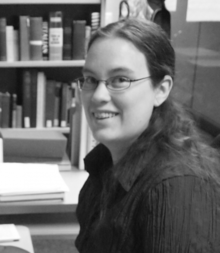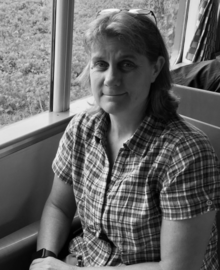
Stanford Libraries have been core to intellectual life on campus since the opening of the university. As instruction shifts online for Spring Quarter, library staff are actively working to continue their support of and partenrship with faculty and students. During National Library Week, we share a few examples of how staff, across various units within the Libraries, quickly pivoted to provide access to resources and minimize the distruption to teaching, learning and research for a new virtual campus environment.
Regina Roberts: Building alliances to help researchers and journalists access and preserve COVID-19 data

Regina specializes in journalism among other subjects at the Libraries. As the COVID-19 pandemic began to unfold, she continued supporting the Big Local News project. Regina activated her network of librarian colleagues at the Graduate School of Business and Lane Medical libraries to source and acquire datasets pertaining to the COVID-19 pandemic. This effort enables researchers and journalists to have access to data on hospitals, nursing homes, vulnerable communities, and daily coronavirus case counts. Regina also worked with student volunteers to add open data sources to the database. Her collaborators included Matt Kiefer, a Stanford-JSK journalism fellow and data editor for the Chicago Reporter, who continued participating in the effort as he drove back home to Chicago just as the shelter in place orders were implemented. Regina is now actively archiving the COVID-19 related data into the Stanford Digital Repository (SDR) for long term preservation, which allows for perpetual access, a major issue for journalists and scholars. Matt Kiefer will continue to assist Regina by working on descriptive metadata solutions during data transfer to the SDR.
Joseph Maloba Makokha: Lending technology & tools to support innovative design

Students enrolled in ME310 are creating prototypes during Spring Quarter to address real world design challenges brought forth by corporate partners. To aid faculty in continuing to provide students with instruction and access to equipment, Joseph Makoha, academic technology specialist for Stanford Libraries, worked with faculty and TAs to lend ME310 the Terman Engineering Library’s maker cart equipped with tools such as a 3D Printer, DuinoKit DKE and Accessories Essentials/Pack, Arduino Based Discovery System and more. Providing access to these tools enables ME310 students who remain on campus or in the surrounding area to continue work on their prototypes in preparation for final demos.
Unlike many other academic engineering projects, which require students to optimize one variable, students must design a complete system while being mindful of not only the primary function but also the usability, desirability, and societal implications. The maker cart is giving students opportunities to prototype and test many of their design concepts, which will improve their full proof-of-concept system.
Ann K.D. Myers: Enhancing rare book catalog records to facilitate discovery of manuscripts fragments used in bindings

Pivoting and having the entire library team work remotely was definitely an undertaking. However, library staff responded quickly to creating a list of projects that remained on “to-do” or “nice to have” lists for far too long. These projects provided staff, like Ann Myers, with opportunities to continue their work remotely. As the Lead Rare Books Cataloger in Special Collections, Ann has been working in collaboration with Benjamin Albritton, Curator of Rare Books, who alerted her to a project that Assistant Professor Rowan Dorin has been doing with his students, where they examined rare printed books with manuscript scraps in the binding, and tried to identify the texts of the manuscripts. A copy of the work can be accessed on SearchWorks, the library’s online catalog. Ann has been going through the report and expanding the Libraries’ catalog records for the books to reflect their research, and to ensure that the records meet our current standards for cataloging manuscript bindings.
Stace Maples: Sharing the influence and power of geospatial data

As head of the Libraries’ Geospatial Center, Stace has led efforts and worked with faculty and students to provide access to datasets and tools that have been on the frontlines of natural disasters, disease outbreaks, and documentation of nomadic populations, among others. The space he occupies within the Branner Earth Sciences Library is typically abuzz with students eager to learn about geographic information systems, looking for guidance on data visualization or simply wanting a collaborator for map and data related projects. Within hours of the shelter-in-place order, Stace and his team moved as much of their in-person services as possible online and created a topic guide for users. For spring quarter, Stace has continued to partner with faculty on instructional support as he has in the past, now leading course geospatial discussions virtually, including a Big Earth Hackathon focusing on wildfire response. While sheltering in place and working from home, Stace received a bounty of good news; he and Dr. Eric Nelson will be published in The Lancet Digital Healthjournal regarding their efforts to map the rapid spread of cholera, and a recently awarded Grand Challenge Explorations grant from the Gates Foundation will enable Stace to continue to work with Stanford medical student Hannah Wild to survey and track the health of nomadic tribes in Ethiopia.
Zeynep Buyukonal: Getting digital resources in the hands of students and faculty while physical access to materials is closed

While already having over 3 million ebooks in its collection, Stanford Libraries has been actively developing solutions to increase access to digital materials for course work and reserves during remote instruction and to ensure the continuity of research. Zeynep was tapped to participate on a library team to explore immediate ways to quickly convert access from physical to digital and accept purchase suggestions by Stanford students and faculty if e-copies were not available in the Libraries’ collection or HathiTrust’s Emergency Temporary Access Service. In her normal role as the Libraries’ Acquisitions Ordering Librarian, library patrons seldom interact directly with Zeynep. Instead, she serves as liaison between vendors and librarians on the purchase of materials and just as importantly developing workflows so these materials are approved quickly and reach students and faculty with ease. So far, over 300 ebooks and streaming videos have been ordered for faculty to support spring courses, and students can submit a digital item service request as a result of the work done by Zeynep and Acquisitions, with Laszlo Jakusovszky and the Access Services team and M.A. Matienzo and colleagues from Digital Libraries Systems and Services.
Josh Schneider: Collecting and preserving Stanford history and community responses to COVID-19

Just as Josh Schneider was shifting from interim to permanent university archivist, the coronavirus began to spread in the United States. Primary to his role is to document the history of the university, including current affairs. Having spent six years dedicated to capturing documentation of Stanford student life as well as official university business, Josh understood the unique situation COVID-19 brought to University Archives and launched the COVID-19 Community Archiving Project to record and preserve history as it happens. Stanford community members are invited to share their experiences and records of daily life during the global pandemic so future students, faculty, and others who wish to better understand how COVID-19 impacted the Stanford community can be documented. Over 125 Stanford faculty, students and staff have submitted journal entries, photographs, poetry, and creative art projects. All submissions will be added to the Libraries’ collections and eventually be available in Green Library. With consent from respondents, all digital content will be added to the Stanford Digital Repository, where it will be preserved, and made broadly accessible online, to demonstrate the experiences and resilience of the Stanford community during this unprecedented time.
Felicia Smith: Chatting to keep undergraduates and the Stanford community connected to campus resources

As the threats of COVID-19 began to grab headlines in mid-March, Felicia and her team of reference and outreach librarians experienced a large spike in inquiries submitted via the online reference feature of the Libraries website. Felicia and her team were fielding questions from worried undergraduates students about resources they had never before accessed online, from concerned graduate students about materials they now had in their possession out of state but were due back to Libraries soon, from faculty about connecting students to course reserves and how to continue to offer library-led Program in Writing and Rhetoric classes. The height of the demand came as Felicia’s team were themselves setting up remote offices in their homes. Inquiries continue at a steady pace as spring quarter commences. With midterms, projects and exams ahead, the volume is expected to peak again. Felicia and her team remain available to answer online reference questions from the Stanford community in real-time Monday-Friday from 10am to 5pm with email reference questions accepted 24/7.
Tony Calavano: Preserving MesoAmerica artifacts in 3D, giving students access and tools to continue reflecting and curating

This spring, Tony Calavano and the Libraries' Digitization Services team have supported the Stanford University Archaeology Center by 3D scanning artifacts from the collection for study and use in the Museum Cultures course, taught by Dr. Christina Hodge. This year's collaboration featured incredible at-scale ink rubbings taken directly from monumental Maya carvings, as well as reduced-scale plaster replicas of architecture elements and artifacts. The digitized ink rubbings can be viewed and accessed online allowing students to access the 3D models online while they attend the course remotely. The 3D models and ink rubbings will be featured in a forthcoming virtual exhibit created by the class.
Ellie Buckley: Keeping users informed and updated on changes during COVID-19

The first few weeks of COVID-19’s spread throughout the United States, and particularly the Bay Area, Ellie Buckley was key to keeping library users and staff updated on the various changes to library hours and access to materials. In addition to her role as Assessment Librarian, Ellie is a member of the Online Experience Group (OEG), a cross-functional team that manages the library’s website, as well as the Libraries’ Department Operations Center (DOC), which is deployed during campus-wide emergencies. Ellie’s participation on the DOC complements her efforts to improve the Libraries emergency preparedness over the past year and half. Ellie worked tirelessly and in partnership with OEG and the Libraries’ Communications team to deploy website banners alerting library patrons to service changes in response to COVID-19. Because of Ellie’s efforts as a member of OEG and DOC, library staff and patrons were informed and able to stay connected to resources vital to their teaching and research.